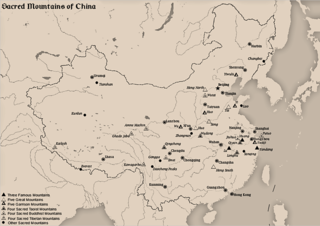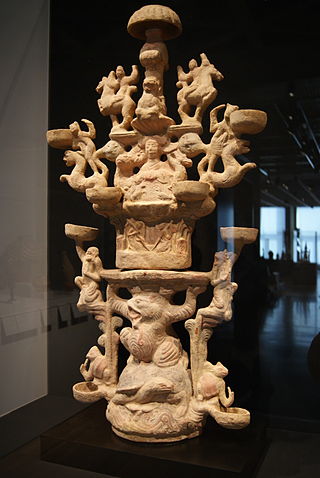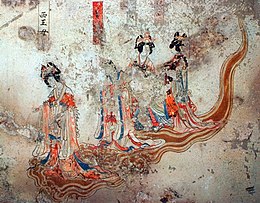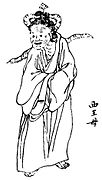
Taoism or Daoism is a diverse tradition indigenous to China, variously characterized as both a philosophy and a religion. Taoism emphasizes living in harmony with the Tao—generally understood as being the impersonal, enigmatic process of transformation ultimately underlying reality. The concept originates in the Chinese word 道, which has numerous related meanings: possible English translations include 'way', 'road', and 'technique'. Taoist thought has informed the development of various practices within the Taoist tradition and beyond, including forms of meditation, astrology, qigong, feng shui, and internal alchemy. A common goal of Taoist practice is self-cultivation resulting in a deeper appreciation of the Tao, and thus a more harmonious existence. There are different formulations of Taoist ethics, but there is generally emphasis on virtues such as effortless action, naturalness or spontaneity, simplicity, and the three treasures of compassion, frugality, and humility. Many Taoist terms lack simple definitions and have been translated in several different ways.

Chinese mythology is mythology that has been passed down in oral form or recorded in literature throughout the area now known as Greater China. Chinese mythology encompasses a diverse array of myths derived from regional and cultural traditions. Populated with engaging narratives featuring extraordinary individuals and beings endowed with magical powers, these stories often unfold in fantastical mythological realms or historical epochs. Similar to numerous other mythologies, Chinese mythology has historically been regarded, at least partially, as a factual record of the past.

The Monkey King or Sun Wukong is a fictional character best known as one of the main players in the 16th-century Chinese novel Journey to the West, and many later stories and adaptations. In the novel, Sun Wukong is a monkey born from a stone who acquires supernatural powers through Taoist practices. After rebelling against heaven, he is imprisoned under a mountain by the Buddha. After five hundred years, he accompanies the monk Tang Sanzang (唐三藏) riding on the White Dragon Horse and two other disciples, Zhu Bajie and Sha Wujing, on a journey to obtain Buddhist sutras from the West (India), where Buddha and his followers dwell.
King Mu of Zhou was the fifth king of the Zhou dynasty. The dates of his reign are 976–922 BC or 956–918 BC.

Chang'e, originally known as Heng'e (姮娥), is the goddess of the Moon and wife of Hou Yi, the great archer. Renowned by her beauty, Chang'e is also known for her ascending to the Moon with her pet Yu Tu, the Moon Rabbit and living in the Moon Palace (广寒宫). She is one of the major goddesses in Chinese mythology, Chinese folk religion, Chinese Buddhism, Confucianism, and Taoism. In modern times, Chang'e is the namesake of the Chinese Lunar Exploration Program.

Chinese folk religion, also known as Chinese popular religion, comprehends a range of traditional religious practices of Han Chinese, including the Chinese diaspora. Vivienne Wee described it as "an empty bowl, which can variously be filled with the contents of institutionalised religions such as Buddhism, Taoism, Confucianism and Chinese syncretic religions". This includes the veneration of shen (spirits) and ancestors. Worship is devoted to deities and immortals, who can be deities of places or natural phenomena, of human behaviour, or founders of family lineages. Stories of these gods are collected into the body of Chinese mythology. By the Song dynasty (960–1279), these practices had been blended with Buddhist, Confucian, and Taoist teachings to form the popular religious system which has lasted in many ways until the present day. The present day government of mainland China, like the imperial dynasties, tolerates popular religious organizations if they bolster social stability but suppresses or persecutes those that they fear would undermine it.

The Sacred Mountains of China are divided into several groups. The Five Great Mountains refers to five of the most renowned mountains in Chinese history, which have been the subjects of imperial pilgrimage by emperors throughout ages. They are associated with the supreme God of Heaven and the five main cosmic deities of Chinese traditional religion. The group associated with Buddhism is referred to as the Four Sacred Mountains of Buddhism, and the group associated with Taoism is referred to as the Four Sacred Mountains of Taoism.

A xian is any manner of immortal, mythical being within the Taoist pantheon or Chinese folklore. Xian has often been translated into English as "immortal".

Dǒumǔ, also known as Dǒumǔ Yuánjūn, Dòulǎo Yuánjūn and Tàiyī Yuánjūn, is a goddess in Chinese religion and Taoism. She is also named through the honorific Tiānhòu, shared with other Chinese goddesses, especially Mazu, who are perhaps conceived as her aspects. Other names of her are Dàomǔ and Tiānmǔ.

The Kunlun or Kunlun Shan is a mountain or mountain range in Chinese mythology, an important symbol representing the axis mundi and divinity.

Cranes are an important motif in Chinese mythology. There are various myths involving cranes, and in Chinese mythology cranes are generally symbolically connected with the idea of longevity. In China, the crane mythology is associated with the divine bird worship in the animal totemism; cranes have a spiritual meaning where they are a form of divine bird which travels between heaven and man's world. Cranes regularly appear in Chinese arts such as paintings, tapestry, and decorative arts; they are also often depicted carrying the souls of the deceased to heaven. The crane is the second most important bird after the fenghuang, the symbol of the empress, in China.

Chinese folk religion plays a dynamic role in the lives of the overseas Chinese who have settled in the countries of this geographic region, particularly Burmese Chinese, Singaporean Chinese, Malaysian Chinese, Thai Chinese and Hoa. The Indonesian Chinese, by contrast, were forced to adopt en masse either Buddhism or Christianity in the 1950s and 1960s, abandoning traditional worship, due to Indonesia's religious policies which at the time forbade Chinese traditional religion or did not recognize it as a "religion," thus making it vulnerable to discrimination. Some Chinese Filipinos also still practice some Chinese traditional religions, besides Christianity of either Roman Catholicism or Protestantism, with which some have also varyingly syncretized traditional Chinese religious practices. Chinese folk religion, the ethnic religion of Han Chinese, "Shenism" was especially coined referring to its Southeast Asian expression; another Southeast Asian name for the religion is the Sanskrit expression Satya Dharma.

Chinese gods and immortals are beings in various Chinese religions seen in a variety of ways and mythological contexts.
Chinese theology, which comes in different interpretations according to the Chinese classics and Chinese folk religion, and specifically Confucian, Taoist, and other philosophical formulations, is fundamentally monistic, that is to say it sees the world and the gods of its phenomena as an organic whole, or cosmos, which continuously emerges from a simple principle. This is expressed by the concept that "all things have one and the same principle". This principle is commonly referred to as Tiān 天, a concept generally translated as "Heaven", referring to the northern culmen and starry vault of the skies and its natural laws which regulate earthly phenomena and generate beings as their progenitors. Ancestors are therefore regarded as the equivalent of Heaven within human society, and therefore as the means connecting back to Heaven which is the "utmost ancestral father". Chinese theology may be also called Tiānxué 天學, a term already in use in the 17th and 18th centuries.
[In contrast to the God of Western religions who is above the space and time] the God of Fuxi, Xuanyuan, and Wang Yangming is under in our space and time. ... To Chinese thought, ancestor is creator.

The Wǔfāng Shàngdì, or simply Wǔdì or Wǔshén are, in Chinese canonical texts and common Chinese religion, the fivefold manifestation of the supreme God of Heaven. This theology dates back at least to the Shang dynasty. Described as the "five changeable faces of Heaven", they represent Heaven's cosmic activity which shapes worlds as tán 壇, "altars", imitating its order which is visible in the starry vault, the north celestial pole and its spinning constellations. The Five Deities themselves represent these constellations. In accordance with the Three Powers they have a celestial, a terrestrial and a chthonic form. The Han Chinese identify themselves as the descendants of the Red and Yellow Deities.

Lishan Laomu is the goddess of Mount Li in Chinese religion. She is a popular female immortal in the Taoist pantheon, and a high-ranking one according to some late sources. Legend has it that Lishan Laomu, whose surname and origin remain mysterious, is a supremely elevated female immortal dwelling deep within the Mount Li. Her origins are said to derive from Nüwa, the legendary creator and mother goddess.
The Eight Pillars also known as Eight Pillars of the Sky are a concept from Chinese mythology. Located in the eight cardinal directions, they are a group of eight mountains or pillars which have been thought to hold up the sky. They are symbolically important as types of axis mundi and cosmology. Their functions in mythology ranged from pillars which functioned to hold apart the Earth and the Sky, as ladders allowing travel between the two, and as the location of various paradises or wonderland with associated magical people, plants, and animals. The Eight Pillars are a central aspect to Chinese mythology, and also have been used extensively in poetic allusion. Some variations exist, such as only having four pillars.

The Weak River also known as the Weak Water or Ruoshui is an important feature in the mythical geography of Chinese literature, including novels and poetry over a course of over two millennia from the Warring States to early Han dynasty era poetry of the Chuci onward. The Weak River is one of the mythological rivers flowing near Kunlun, home of a Western Paradise. The Weak River flowed with "water" so lacking in specific gravity that even a feather would not float, thus being a protective barrier against the unworthy, who otherwise would profane the paradise on Kunlun, and perhaps even climb up to Heaven and disturb the deities and other inhabitants residing there. In the novel Journey to the West, the Weak Water River forms one of the obstacles the fictional version of the monk Xuanzang, the magic monkey Sun Wukong, and companions must cross over on their mission to fetch the Buddhist scriptures from India and return them to Tang China.

The roles of women in Taoism have differed from the traditional patriarchy over women in ancient and imperial China. Chinese women had special importance in some Taoist schools that recognized their transcendental abilities to communicate with deities, who frequently granted women with revealed texts and scriptures. Women first came to prominence in the Highest Clarity School, which was founded in the 4th century by a woman, Wei Huacun. The Tang dynasty (618–907) was a highpoint for the importance of Daoist women, when one-third of the Shangqing clergy were women, including many aristocratic Taoist nuns. The number of Taoist women decreased until the 12th century when the Complete Perfection School, which ordained Sun Bu'er as the only woman among its original disciples, put women in positions of power. In the 18th and 19th centuries, women Taoists practiced and discussed nüdan, involving gender-specific practices of breath meditation and visualization. Furthermore, Taoist divinities and cults have long traditions in China, for example, the Queen Mother of the West, the patron of xian immortality, He Xiangu, one of the Eight Immortals, and Mazu, the protectress of sailors and fishermen.













![[Xian Shan ] Bi {Xi Wang Mu Tu } .jpg](http://upload.wikimedia.org/wikipedia/commons/thumb/8/81/%E3%80%8C%E9%96%92%E5%B1%B1%E3%80%8D%E7%AD%86%E3%80%8E%E8%A5%BF%E7%8E%8B%E6%AF%8D%E5%9B%B3%E3%80%8F.jpg/65px-%E3%80%8C%E9%96%92%E5%B1%B1%E3%80%8D%E7%AD%86%E3%80%8E%E8%A5%BF%E7%8E%8B%E6%AF%8D%E5%9B%B3%E3%80%8F.jpg)























